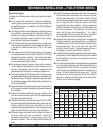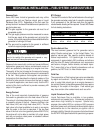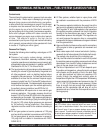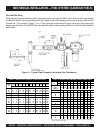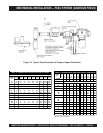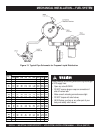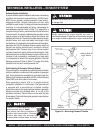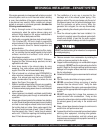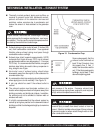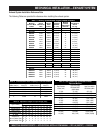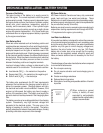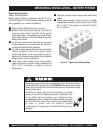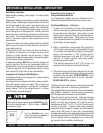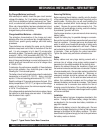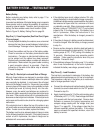
INDUSTRIAL GENERATOR SETS — APPLICATION & INSTALLATION MANUAL — REV. #4 (09/07/07) — PAGE 47
DO NOT use flexible tubing to form bends or to compensate
for misaligned piping.
Reduce corrosion from condensation by installing the
muffler as close as practical to the engine.
Support mufflers and piping by non-combustible hangers
or supports. DO NOT
use the engine exhaust outlet for
support. Weight on the engine exhaust outlet can cause
damage to the engine exhaust manifold or reduce the
life of a turbocharger.
Schedule 40 black iron pipe is recommended for exhaust
piping.
Pipe bend radius should be as long as practical.
NEVER use exhaust tubing and piping of smaller
diameter than the exhaust outlet. Verify the back
pressure limitation of the engine, and use exhaust tubing
and piping of the appropriate size throughout the exhaust
system.
DO NOT use piping that is larger than necessary to
avoid corrosion from condensation. Doing so also
reduces the exhaust gas velocity available for dispersing
the exhaust gases up and away in the outdoor wind
stream.
Keep exhaust pipe diameter changes to a minimum to
avoid friction and performance loss.
A genset should not be connected to an exhaust system
servicing other equipment, including other gensets.
Soot, corrosive condensation, and high exhaust gas
temperatures can damage idle equipment served by a
common exhaust system.
MECHANICAL INSTALLATION — EXHAUST SYSTEMIf the engine-generator is not equipped with a factory mounted
exhaust system, such as a unit mounted inside a building
or room, the installation of the engine exhaust system has
to be planned very carefully. When installing an exhaust
system on an open or un-housed generator, consider the
following recommendations:
1. After a thorough review of the exhaust installation
requirements, select the engine silencer, piping and
exhaust fittings based on the engine manufacturer’s
maximum exhaust backpressure limits.
2. Use flexible, corrugated stainless steel exhaust tubing,
12 to 18 inches (305 - 457 mm) in length, to connect the
exhaust silencer to the engine exhaust outlet. This tube
or flex connector allows for thermal expansion and
engine vibration.
3. Be sure to support the exhaust system (muffler, piping,
etc.) to minimize the total weight applied to the engine
exhaust manifold and exhaust outlet elbow or
turbocharger connection.
4. Exhaust piping should conform to NFPA 37, Stationary
Engines and Gas Turbines design practices, and any
applicable local codes.
5. Avoid sharp bends in the exhaust piping by using
sweeping, long radius elbows and provide adequate
support for muffler and all associated piping.
6. Pitch a horizontal run of exhaust pipe DOWNWARD to
allow moisture condensation to drain away from the
engine. If an exhaust pipe must be turned UPWARD,
install a condensation trap at the point where the rise
begins. See Figure 15 on page 48.
7. Shield or insulate exhaust piping if there is any possibility
of personal contact. Allow at least 12 inches (305 mm)
of clearance where piping passes close to a combustible
wall or partition.
8. Use an approved, insulated & ventilated, metal thimble
where exhaust pipes pass through a combustible wall
or partition.
9. Always pipe exhaust gases to the outside of any building
or room. Route the engine exhaust away from any building
air inlets to avoid engine exhaust fumes from entering
the building fresh air intake. Some codes specify that
the exhaust outlet terminate at least 10-feet (3 meters)
from the property line, 3-feet (1 meter) from an exterior
wall or roof, 10-feet from openings into buildings and at
least 10-feet above any adjoining grade.
10. The installation of a rain cap is required for the
discharge end of the exhaust system piping, if the
piping is vertical. The rain cap clamps onto the end of
the pipe and opens from the exhaust discharge force
from the generator set while running. When the
generator set is stopped, the rain cap automatically
closes, protecting the exhaust system from rain, snow,
etc.
11. Once the exhaust system has been installed, it is
important to regularly inspect the exhaust system both
visually and audibly to see that the entire system
remains sealed against leakage and safe for operation.
MECHANICAL INSTALLATION — EXHAUST SYSTEM



